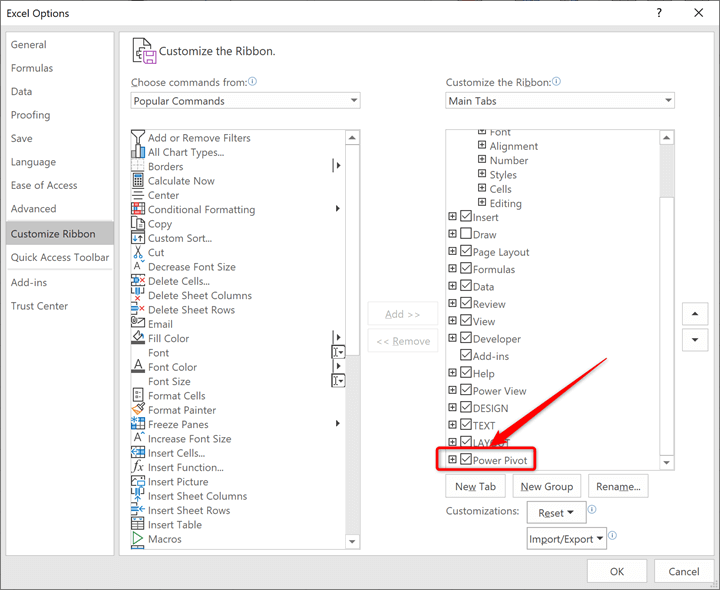Powerpivot Excel 2011 Mac Download
Pivot Tables are powerful business tools that are used to summarise and make sense of large multi-column lists of raw data. Pivot Tables can be created in un. I've been unable to do this in (mac) excel 2011 but I just took a file created in 2011, turned on this option in 2016 (option does exist in mac office 2016) and then re-opened file in 2011. The setting stuck thru data refreshes and minor table changes such as adding additional fields in the 'Values' section.
In Excel 2011 for mac, a PivotTable is a special kind of table that summarizes data from a table, data range, or database external to the workbook. If you’re PivotTable aficionado, you will be in seventh heaven with the new PivotTable capabilities in Office 2011 for Mac. Here’s how to make a PivotTable:
- MS Excel 2011: Pivot Tables (Tutorial Complete) Congratulations, you have completed the Excel 2011 tutorial that explains Pivot Tables in Excel 2011 for Mac. Tutorial Summary. Excel 2011 is a version of Excel developed by Microsoft that runs on the Mac platform. Each version of Excel can 'look and feel' completely different from another.
- Oct 18, 2018.
- Feb 20, 2013.
- Oct 05, 2015.
- Question: In Microsoft Excel 2011 for Mac, I've created a pivot table and now I need to change the data source. How do I change the data source for an existing pivot table? Answer: Click somewhere in the pivot table and the PivotTable tab should appear in the toolbar at the top of the screen. Select the PivotTable tab, click on the Options button and select Change Source from the popup menu.

(Optional) Select a cell in your data range or table.
Choose Data→PivotTable. Alternatively, on the Ribbon’s Tables tab, go to the Tools group and click Summarize with PivotTable.
Choose the data to analyze:
Make choices from the following options:
Location: If you performed Step 1, your table or range is already filled in for you. If you didn’t start with a table or range, you can select a data range or table using the mouse.
Use an External Data Source:Displays the Mac OS X ODBC dialog.
Choose where to put the PivotTable:
New Worksheet: If selected, adds a new sheet to the workbook and places your PivotTable in Cell A1 of the new worksheet.
Existing Worksheet:Choose a cell on your worksheet. The cell will be the upper-leftmost corner of your PivotTable. Make sure there’s enough room so your PivotTable doesn’t overlap existing cell ranges.
Click OK.
Drag field names from the Field Name section at the top to the panes below.
Selecting and deselecting the field names includes or excludes the columns from the pivot table.
Clicking the pop-up buttons within the pivot table displays Filter dialogs appropriate for the data type in your pivot table.
You can filter the Field Name list by typing field names in the search box in the Pivot Table Builder dialog.
Drag fields from one pane to another to generate new pivot table variations.
You can change the column names, calculations, and number formats provided by the PivotTable Builder. There’s a little information button at the right end of each field name in the panels at the bottom of the PivotTable Builder. Click the information button to display the PivotTable Field dialog. The properties displayed are for the field name of the button you clicked:
Field Name (Optional): Type a new field name.
Summarize By: Choose which type of calculation to use.
Show Data As: Select how you want to show the data from the pop-up menu. You can choose from Normal, Difference From, % Of, % Difference From, Running Total In, % of Row, % of Column, % of Total, or Index.
Base Field and Base Item: If you choose Difference Fromin the Show Data As pop-up menu, choose which fields you’re comparing.
Delete: Removes this field from the PivotTable report.
Number: Displays the Number tab of the Format Cells dialog so you can choose a number format or make a custom number format.


Powerpivot Mac Excel
When you select a cell in a PivotTable, look at the Ribbon to find the PivotTable tab, which you click to display all sorts of PivotTable tools. The PivotTable tab is for experts. PivotTable Ribbon offers additional formatting options and still more controls for your PivotTable, but it goes beyond the scope of this book. If you find PivotTables to be useful, then by all means explore the PivotTable Ribbon.